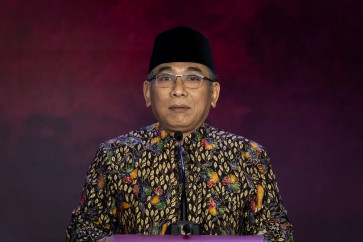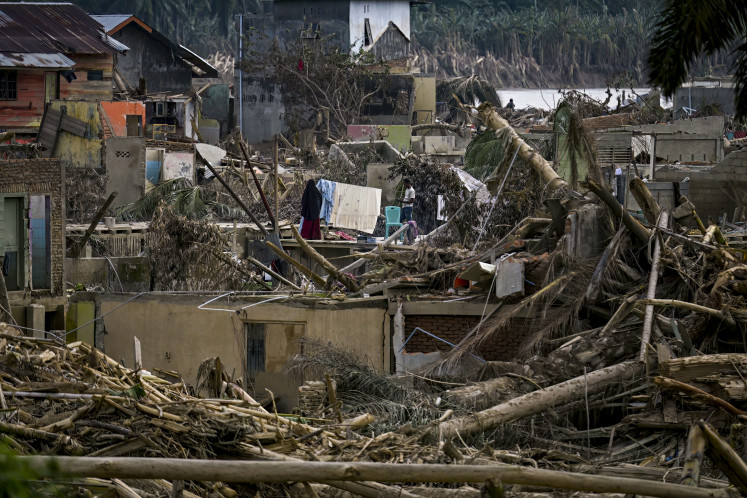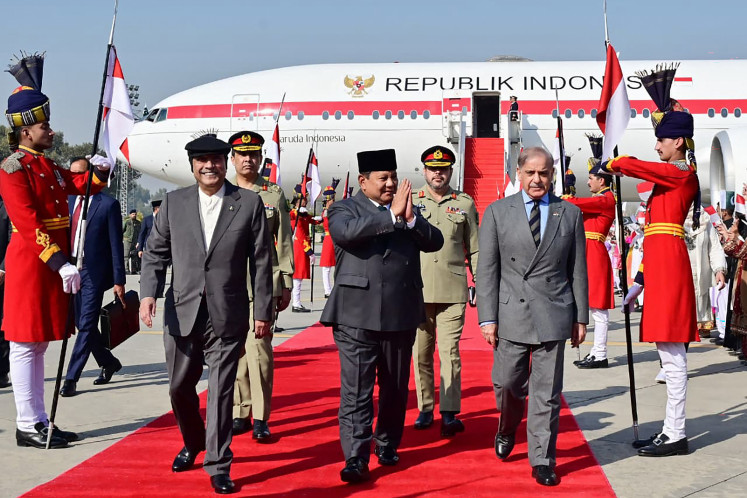Popular Reads
Top Results
Can't find what you're looking for?
View all search resultsPopular Reads
Top Results
Can't find what you're looking for?
View all search resultsProtecting Indonesia's electricity grid to prevent power crisis
From David and Goliath to Luke Skywalker and the Death Star, the human race has been reminded again and again that âbig thingsâ have âvulnerable pointsâ
Change text size
Gift Premium Articles
to Anyone
F
rom David and Goliath to Luke Skywalker and the Death Star, the human race has been reminded again and again that 'big things' have 'vulnerable points'.
The Indonesian nation's electrical power grid, sometimes referred to as the nation's largest machine, is no exception.
So it was little surprise to read foreign reports earlier this year that the coordinated destruction of key substations of the state electricity company PT PLN by terrorists could very effectively knock out power, throughout Sumatra, Java and Bali.
Let's be very clear, this would not be a flicker of lights, but an outage that could last weeks or even months, a blow to Indonesia's electricity steeped economy.
We've heard similar warnings from others before. For example, in the US, as far back as 1982, Amory and Hunter Lovins raised the issue in, Brittle Power: Energy Strategy for National Security. Talk of the US grid's susceptibility heightened following the 9/11 attack.
Again after the Northeast Blackout of 2003, then again last year when gunmen destroyed 17 transformers in an attack on US Pacific Gas & Electric equipment.
Such threats aren't being ignored by Indonesia. Government action is now under way to better guard the nation's power grid. But, with so much awareness of the problem, why are we focusing mostly on fences, sentries and CCTV surveillance, instead of fixing the root cause?
Any power grid's weakness lies in its interconnectedness, which can lead to domino-like failures that can quickly traverse regions. We can reduce this vulnerability by adding 'decentralized energy', i.e. dispersed power generation, energy storage, and microgrids that supply power ' even when the Nation's grid is down.
UK energy development engineering consultancy, SBS Intl Ltd (SBS), an organization that has focused on this very issue, says it would not take a lot of decentralized energy to make a big difference, at least in the early stage of a power grid crisis.
'In an emergency, even a very small penetration of distributed generation, deployed in the right places, can make a huge difference to human welfare by providing essential services ' supporting first responders and enabling supply chains for critical goods.
'This could be achieved by providing emergency electricity services, delivered by distributed resources, to only 1 [one] percent of the load that is normally served by the grid,' it says, adding, 'While 1 percent would get Indonesia through an emergency, it would need far more 'dispersed energy' [Dispersed energy is the term uses to describe distributed generation that is not connected to the national grid, and is therefore, spared when a cascading national grid failure occurs] if the grid outage lasted weeks or months in order to sustain supply chains for essential goods and emergency services'.
Microgrids are another form of energy infrastructure that can supply power in a crisis. While they can be connected to the grid, they also have the ability to disconnect and act as self sufficient, mini-grids.
'Existing microgrids can provide separate or 'islandable' power systems: systems that can continue operating on a stand-alone basis if the nation's grid goes down, especially (e.g.) for military bases, university campuses and essential medical support facilities.'
What about the Solar PV (photovoltaic) and Wind Farm systems Indonesia has recently added? True, by the end of 2014, according to the government's new and renewable energy division of the Energy and Mineral Resources Ministry, Indonesia may have enough solar and wind devices to power almost 200,000 homes. Unfortunately, most of it is connected to the national grid so, when the grid fails, it goes off.
Meanwhile, most of the nation's dispersed power generation (DPG) in remote population areas continues to use diesel-fuelled generators.
In a recent PLN feasibility report which addresses the development costs and potential benefits of deploying small-scale liquefied natural gas (LNG) to the eastern region of Indonesia, the report quotes that, 'by assuming
diesel engine efficiency of 65 percent and gas engine efficiency of 30 percent and, by taking electricity cost on Java Island as 100 percent basis, electricity cost in the eastern part of Indonesia (Papua, Maluku, East and West Nusa Tenggara, South, South East, North and Central Sulawesi) is up to five times higher due to the excessive use of diesel fuel'.
According to Moh. Taufik Afianto, the Business Development General Manager of state-owned oil company PT Pertamina, 'In the eastern part of Indonesia, many power plants in scattered locations are still consuming diesel fuel as their base-load power generation system. This trend is suggested by the limited access for cheaper forms of energy due to archipelago-geographic constraints. On the other hand, government subsidy on diesel fuel for power generation is excessive and needs to be addressed immediately.'
Unfortunately, most of these systems are simply back-up diesel or propane-powered generators, so they are both environmentally dirty and vulnerable to interruptions in the fuel supply,' SBS says.
To be able to supply a constant power supply, DPG should be coupled with energy storage and/or integrated into microgrids to reduce or eliminate the need for grid back-up power.
Microgrids should also be part of the solution for Indonesia. These are community-scale energy networks that generate most of their power from DPG and use super-efficient buildings and energy storage to reduce power needs.'
PLN has taken action to shore-up physical protection of the nation's electrical power grid through new rules for utilities and, in conjunction with the Energy and Mineral Resources Ministry, new policies are being finalized to encourage more independent power providers (IPP) to invest in the latest technology of proven renewable energy devices such as ocean energy power-generating turbines.
The government has ordered PLN to propose standards that will guide how its national utility company will decide how best to protect the nation's critical energy facilities. The order doesn't require grid decentralization.
However, in a separate opinion, the government requested PLN to at least provide a plan toward bringing greater intelligence to the nation's power grid.
According to SBS study, PLN simply cannot erect enough barriers to protect its over 100,000 circuit kilometers of transmission, and more than 5,000 transmission substations.'
Instead, SBS calls for 'building a smarter and more agile national grid, which would discourage attacks, by ensuring that power will continue to flow to consumers even if certain elements of the grid are harmed'.
The choice seems pretty clear for Indonesia. If we don't fix the root problems that threaten the Indonesian national power grid by adding more decentralized and intelligent renewable energy resources, in a few short years we'll likely again be revisiting the issue of national energy security, following yet more outages and calamities which goes to show that, while the grid is growing, it's certainly not too big not to fail'¦
_________________
The writer is group chairman & CEO for SBS Intl Ltd. The views expressed are his own.










